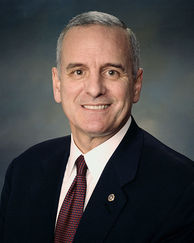What Are Mark Dayton’s True Reelection Odds?
Prognosticators list the Minnesota gubernatorial seat as ‘safe’ for the incumbent in 2014; history suggests the odds are just shy of that
So long as the Republican Party of Minnesota doesn’t put forth a candidate against Mark Dayton in 2014, it is hard to argue with the many analysts who are calling the Gopher State’s gubernatorial race as a ‘safe’ hold for the DFL.
Of course, Republicans will field a candidate at some point.
After all, the GOP has done so in all 65 such gubernatorial races in state history. (A feat Democrats cannot claim, failing to do so in 1936 at the peak of Farmer-Laborite fever in the state).
And that’s why it seems difficult at first blush to think that a light blue / purplish state like Minnesota could once again host a not-even-close-to-competitive statewide election next year, on the heels of Amy Klobuchar’s 2012 U.S. Senate blowout victory, particularly with a candidate who won the governor’s mansion by less than a half a percentage point the last go-around.
True, Dayton is an incumbent this time, with a shade above a moderately good approval rating, and that does grant him an added home court advantage when he runs again in 2014.
Add to that the fact that the Minnesota GOP has gone through difficult financial and electoral times ever since Dayton’s razor-thin 2010 victory – yielding back both legislative chambers in St. Paul and one U.S. House seat in the last cycle.
But, even incumbents get beat, right?
79 Percent?
In fact, they do.
Slightly more than one in five Minnesota gubernatorial incumbents in state history lost their reelection bids, or nine out of 42 attempts.
That number includes Adolph Eberhart, who sought election for a third term in 1914 but lost his party’s primary to William Lee. (The GOP lost the seat to Winfield Hammond that cycle).
Eberhart was the second incumbent to seek reelection and fail – 14 years after Democratic incumbent John Lind lost by less than a point to Republican Samuel Van Sant in 1900.
After Eberhart came Famer-Laborite Elmer Benson in 1938, who was dealt a 25.7-point blow-out defeat at the hands of Republican Harold Stassen.
On 22 occasions Gopher State governors have opted to retire from public life, sought another office, or decided not to run for reelection for other reasons.
Each of Minnesota’s last three governors fall into one of these categories – Arne Carlson, Jesse Ventura, and Tim Pawlenty – although Carlson’s predecessor, Rudy Perpich, was defeated when he sought a third consecutive term in 1990.
55 Percent?
Perpich actually lost twice as an incumbent – in 1978 (after ascending to the governorship when Wendell Anderson essentially appointed himself to the late Hubert Humphrey’s U.S. Senate seat) and in 1990.
Overall, Democratic/DFL incumbent governors – and there have been comparatively few in the history of the Gopher State – have won only six of 11 reelection bids, or just 55 percent of the time.
In addition to Lind (1900) and Perpich (1978, 1990) mentioned above, other failed Democratic incumbent reelection campaigns were launched by Orville Freeman in 1960 (losing by 1.5 points to Elmer Andersen) and Karl Rolvaag in 1966 (losing by 5.7 points to Harold LeVander).
On the positive side of the ledger are reelection victories by Governors John Johnson (1906, 1908), Orville Freeman (1956, 1958), Wendell Anderson (1974), and Rudy Perpich (1986).
Only two Republican governors have lost their seat in the general election (C. Elmer Anderson in 1954 by 5.9 points to Freeman and Elmer Andersen in 1962 by 91 votes to Karl Rolvaag) against 25 victories, or a 93 percent winning percentage.
Follow Smart Politics on Twitter.

